OCZ’s Vertex Limited Edition Review & SSD State of the Union
by Anand Lal Shimpi on February 19, 2010 12:00 AM EST- Posted in
- Storage
Overall System Performance using PCMark Vantage
Next up is PCMark Vantage, another system-wide performance suite. For those of you who aren’t familiar with PCMark Vantage, it ends up being the most real-world-like hard drive test I can come up with. It runs things like application launches, file searches, web browsing, contacts searching, video playback, photo editing and other completely mundane but real-world tasks. I’ve described the benchmark in great detail before but if you’d like to read up on what it does in particular, take a look at Futuremark’s whitepaper on the benchmark; it’s not perfect, but it’s good enough to be a member of a comprehensive storage benchmark suite. Any performance impacts here would most likely be reflected in the real world.
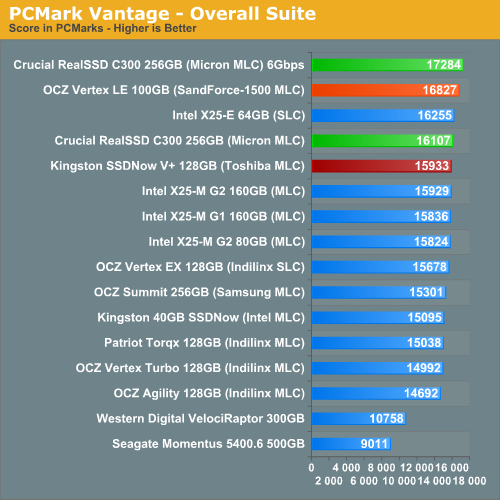
The performance differences under PCMark Vantage are minimal between any halfway decent SSDs. This actually mimicks what you'll see in most real world usage with these drives. It's the same reason I don't use individual application launch tests to compare performance - all of these drives perform about the same. The being said, the Vertex LE is technically the fastest 3Gbps drive here, behind only the C300 connected to a 6Gbps controller. The new Kingston drive does very well here.
The overall standings are something you'll see repeated in most of the subtests. Crucial and OCZ trading blows at the top, with the 6Gbps controller often giving Crucial the slight edge.
The memories suite includes a test involving importing pictures into Windows Photo Gallery and editing them, a fairly benign task that easily falls into the category of being very influenced by disk performance.
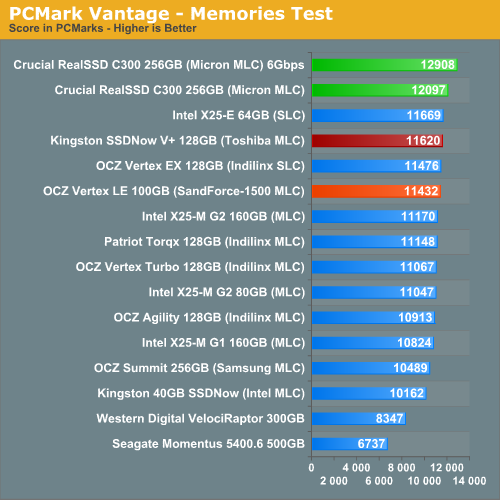
The TV and Movies tests focus on on video transcoding which is mostly CPU bound, but one of the tests involves Windows Media Center which tends to be disk bound.
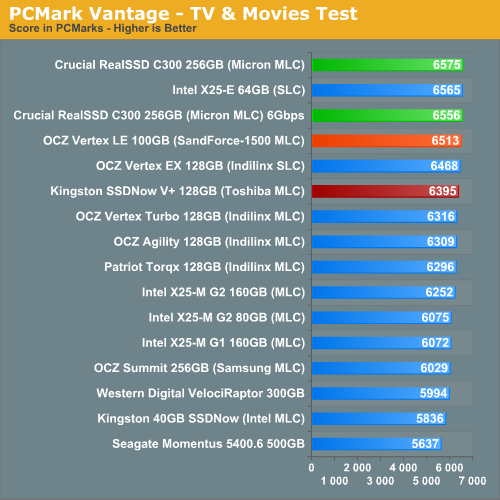
The gaming tests are very well suited to SSDs since they spend a good portion of their time focusing on reading textures and loading level data. All of the SSDs dominate here, but as you'll see later on in my gaming tests the benefits of an SSD really vary depending on the game. Take these results as a best case scenario of what can happen, not the norm.
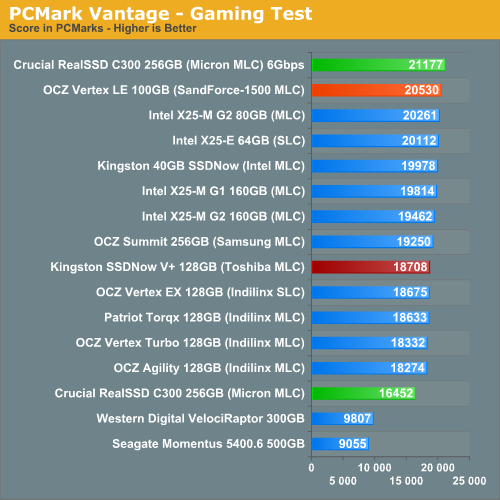
In the Music suite the main test is a multitasking scenario: the test simulates surfing the web in IE7, transcoding an audio file and adding music to Windows Media Player (the most disk intensive portion of the test).
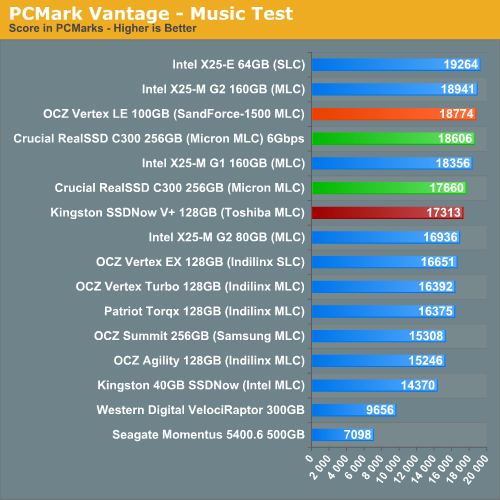
The Communications suite is made up of two tests, both involving light multitasking. The first test simulates data encryption/decryption while running message rules in Windows Mail. The second test simulates web surfing (including opening/closing tabs) in IE7, data decryption and running Windows Defender.
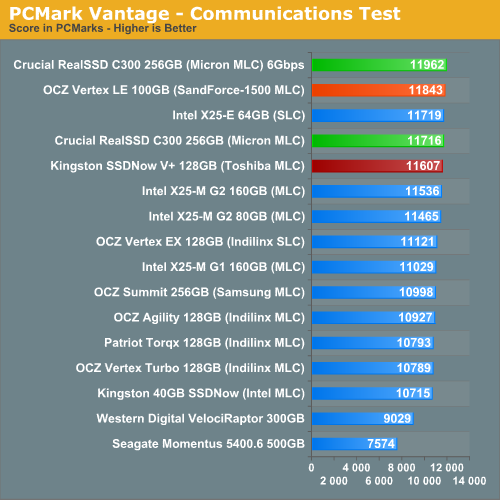
I love PCMark's Productivity test; in this test there are four tasks going on at once, searching through Windows contacts, searching through Windows Mail, browsing multiple webpages in IE7 and loading applications. This is as real world of a scenario as you get and it happens to be representative of one of the most frustrating HDD usage models - trying to do multiple things at once. There's nothing more annoying than trying to launch a simple application while you're doing other things in the background and have the load take forever.
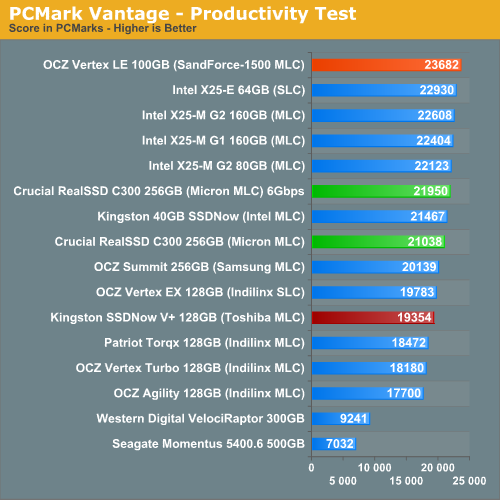
There's just no replacement for IOPS, and the Vertex LE has ample to spare. This is one of the only cases in PCMark Vantage where the SandForce-1500 based drive pulls clearly ahead of the C300.
The final PCMark Vantage suite is HDD specific and this is where you'll see the biggest differences between the drives:
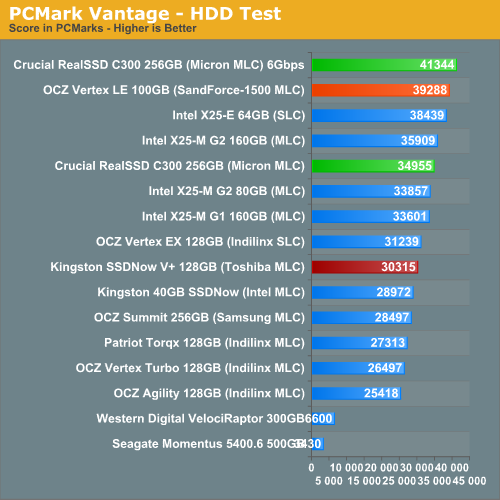
The HDD test is purely I/O bound and connected to a 3Gbps controller, the Vertex LE is clearly the fastest thing here. Around 9% faster than Intel's X25-M or Crucial's RealSSD C300. Pair the C300 with a 6Gbps controller however and it's the unequivocal performance leader. If you have a motherboard with 6Gbps SATA on-board, this is the SSD you'll want.










83 Comments
View All Comments
v12v12 - Tuesday, February 23, 2010 - link
"To calm your fears, OCZ is selling the Vertex LE with a 3 year warranty."Umm 3yrs is CRAP! It's the industry standard among ALL HDs... again, how many times do I have to catch Anand-staff soft-wrist-slapping these con-artist manufacturers?! Who's "assured" with a 3yr warranty vs what? I haven't seen any manu offering lower? So how's that a selling/assurance point... let alone if it's even VALID to list in this article?
What you should have said (if at all) was:
"To calm your fears, OCZ is selling the Vertex LE with a STANDARD 3 year warranty (just like everyone else)." Hahaha.
I just don't get how you can continue to soft-scold (more like a notation) these manufactures when you and I KNOW it's crap. Well Okay I DO know; you're smart and running a business/review site (pro-business) and you don't wanna bad mouth these guys like you OUGHT to do. So instead you'll give them wrist slaps at the end of all the journalist-sensationalism in order to wash over the apparent chicanery of these businesses, so they'll keep sending you beta/new samples... Yes I know how the POLITICS of "business" works these days; sucks for the avg-minded consumer who totally misses keystone issues like this for all the hype and grandeur laced commentary... Sigh, the consumer-cattle loses again.
OWC Grant - Tuesday, February 23, 2010 - link
FWIW to this discussion thread and wasn't covered in the brief mention, the OWC Extreme Enterprise comes with an enterprise class level warranty...FIVE years. So, based on pricing and other similarities, will leave it up others to decide what the best value/performance ratio is in SSDs.kunedog - Tuesday, February 23, 2010 - link
Let's also not forget that he *never* acknowledged the near-immediately stratospheric pricing of Intel's G2 X-25M, right after he praised its affordability:http://www.anandtech.com/storage/showdoc.aspx?i=36...">http://www.anandtech.com/storage/showdoc.aspx?i=36...
He mentioned the firmware problems and lack of stock once but never the pricing.
ONLY now, over 6 months later, do we see prices anywhere near what he predicted at release:
80GB for $220
http://www.newegg.com/Product/Product.aspx?Item=N8...">http://www.newegg.com/Product/Product.aspx?Item=N8...
160GB for $430
http://www.newegg.com/Product/Product.aspx?Item=N8...">http://www.newegg.com/Product/Product.aspx?Item=N8...
The 160GB comes with a free Apricorn USB enclosure, the same one "randomly plugged" here by Anand. It's a strange coincidence to see two sites decide to associate it with SSDs (why would you put an SSD in an USB enclosure?).
shin0bi272 - Monday, February 22, 2010 - link
I thought I saw a review on anandtech a few months ago about the corsair p128 which was supposed to be a great ssd. But its not included on these benchmarks. Its supposed to have 220mb seq read and 200mb seq write. yet its not included? why?OWC Grant - Monday, February 22, 2010 - link
Glad to see so much interest in SSD!As Anand was made aware, our earliest units went out to reviewers and we contacted him and other reviewers to get these units back upon learning of a firmware revision that became available early Feb. In direct communication with him, he noted that neither firmware version had any effect on the performance.
All other OWC SSD units in the field (and available with same day to 1 day delay shipping from OWC) do have the latest firmware revision.
So, we are not "a bit behind OCZ" in this regard.
Hope this clears up the matter...and that you get an OWC SSD for yourself!
smith11 - Monday, February 22, 2010 - link
There's something that I'm not getting...If there's 0.5x write amplification because of real-time compression, why wouldn't the effective capacity be a good bit higher than (the non-reserved part of) the physical capacity ???
GullLars - Monday, February 22, 2010 - link
When i was reading this test, i couldn't help but think on several occasions that a cheap RAID of 3-4 intel x25-V from ICH10R would beat many of the drives tested here, and at a lower price.4 x25-V in RAID 0 gives 160GB capasity, roughly 600 MB/s seq read (limited by ICH10Rs bandwidth), about 140-150 MB/s seq write, around 100.000 4KB random read IOPS (400MB/s) at higher queue depths, and about 40.000 4KB random write IOPS (120MB/s). At a price point around $400-450, wich is about the same as Intel x25-M G2 160GB costs...
I think it would be great if Anand could do a test with 4 x25-V in RAID 0 from ICH10R to demonstrate a budget concious enthusiast setup.
semo - Monday, February 22, 2010 - link
Hi Anand,Great article. Any word on PCI-e SSDs? Are you leaving them out because of high costs or other reasons?
Also, good to know that you have our backs if those SSDs start crapping out. Without people like you companies get away with it for a long time.
rubbertoe - Sunday, February 21, 2010 - link
Looks like Amazon is also selling the 100G version:http://www.amazon.com/gp/product/B0035RQZSG/ref=pd...">http://www.amazon.com/gp/product/B0035R...X0DER&am...
Can someone confirm this is the drive that was reviewed? With selling only 5,000 does anyone have any idea how they will be distributed into the retail channels?
RT
neoflux - Sunday, February 21, 2010 - link
The OCZ Agility uses Intel 50nm or Toshiba 40nm flash.The OCZ Solid 2 uses Intel 34nm flash.
The OCZ Vertex uses Samsung flash, but what SIZE?
And based on that size, if the controller is the same as Anand mentioned a few articles ago, is the Solid 2 faster or at least the same speed-wise as the Vertex?
I did find that the Solid 2 may actually have some sort of 'crippled' Indilux controller, but that was just some forum, not an article.
I have gone back through all the Anand articles and googled everything I could think, but could not find the answer.
Someone enlighten me as to the size of the flash and the speed compared to the Vertex?